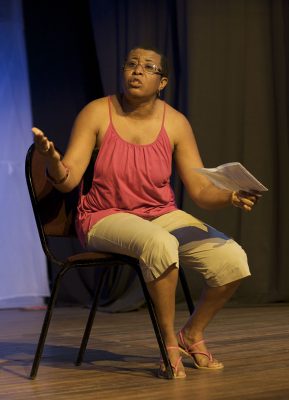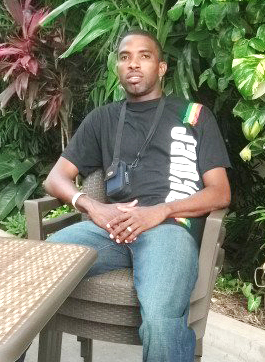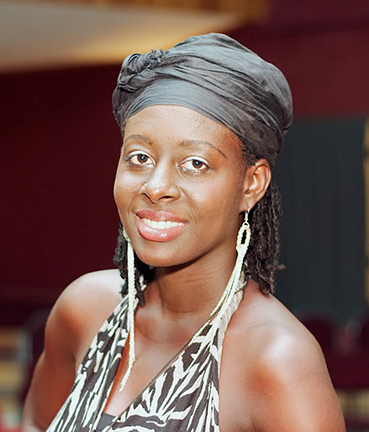It may be said that Guyana’s newest feature film was released last week. One may refer to the work that was released in that fashion, but one may call it something else, because the movie titled The Helpline is not what it was intended to be. The producers set out to do one thing to fulfil a mission but found themselves with quite something else.
It was a big occasion at the National Cultural Centre last Tuesday when Merundoi Incorporated, producers of the popular radio serial drama and various pieces of community theatre had the premiere screening of the film The Helpline directed by Kojo McPherson. The event was moderated by Executive Producer of the movie and Head of Merundoi Margaret Lawrence, who is also Administrator of the National School of Theatre Arts and Drama (NSTAD).
The making of the film was a collaborative effort since the work and its elaborate launching were under the aegis of The European Union and co-presented by Merundoi, Youth Challenge Guyana (YCG) and Family Awareness, Consciousness, Togetherness (FACT). The launch was addressed by Ambassador Jernej Videtic, Head of the European Union Delegation in this corner of the world, as well as Dmitri Nicholson representing YCG and Dr Suzanne Siebs on behalf of the Ministry of Public Health.

That impressive cast of dignitaries and the organisations that they represented tell something of the importance of the film, as well as its purpose and original intention. Merundoi has always been concerned with drama in education, with the performing arts for social purpose, and that is the drive behind the making of The Helpline. It is obviously a work designed to dramatise a social issue and communicate a message to the general public. Among its main functions are public awareness of such social ills as domestic abuse and suicide prevention. It dramatizes the way unsuspecting parents can leave their children vulnerable to abuse and can be oblivious to the red flags and warning signs when teenagers are in trouble and when things get so deep that they are en route to suicide. The work performed for the screen dramatizes a typical situation or case study.
The plan is to serialise it, to show the story in episodes on local television, and a number of TV stations have already committed to carry the series. In this, Merundoi has extended its work to add another dimension to the long-running radio soap opera titled “Merundoi”. That is the purpose of the radio serial and this initiative is to take a similar social realism to the TV screen. But this work, a moving drama written by Mosa Telford, already famed as a prize-winning playwright, outgrew those modest intentions and ended up as something higher – a full-length film with its own artistic characteristics, shape and structure. It tore up the script of an episodic TV ‘soap’ and took its place as the latest in a long line of Guyanese feature films – a creative melodrama.

That long line includes a few legendary achievements, some of historical significance, and a number of failed efforts. But The Helpline is among the better stand-outs. The archives will offer up the pioneering If Wishes Were Horses, and the well-meaning Song of the Sugarcanes, while in more recent times there were Mahadeo Shivraj’s A Jasmine For A Gardener, the popular comedies Jezebel and Till Ah Find A Place, to be added to others like Guiana 1834. Apart from the full-length movies, there are several short films which form an interesting collection.
McPherson’s The Helpline joins the list and does not resemble the typical serial. One needs to be reminded, however, that among the best works of fiction are those that were first published in serialized form in periodical magazines. Charles Dickens, for example, was known to first publish novels that way, and the masterpiece Great Expectations was one of them. In the Caribbean there was the newspaper editor turned novelist Herbert G. De Lisser, who serialised his novels in Jamaica.

Telford’s plot is artistically presented as the story is mainly narrated by the central character Calista, a teenaged girl played by Anya Downes, who tells her story to her friend Jairo played by Kwesi Lewis from a kind of limbo land. Although it is narrated in parts which are interspersed with flashbacks, it is one fluent, unbroken tale as presented to the audience, so seamless there are no chapters or breaks. There is suspense but no scene endings as the various sequences flow ceaselessly into each other without a natural break. Playwrights will at times use cinematic effects and styles, but, ironically, this is a film with the narrative, dialogue and flashbacks of a stage play.
Like a stage play, it is heavily carried by words but the director’s cut is intriguing as McPherson tries techniques with considerable artistry of his own. The Guyanese audience would have seen his work before both on stage and screen. Just as his most recent direction on stage – Legend of Baby, was his best, so does his most recent work for the camera show recognisable improvement upon his short films. The longest work, The Helpline, is his most impressive.
It is not flawless. There is inconsistency in the sound, so that the quality fluctuates and is sometimes not clean, especially in the early sequences. The music enhancement is sometimes hard to describe as background music as it often drives the action – whether for mood, suspense, pace or whatever else, it occasionally threatens to dominate. Clearly there is artistic intention in its use, but its volume, deployment and imposition might just be at times heavy-handed.
The performance is good all-round, sometimes outstanding. Most fascinating is Anya Downes’ creation of the role of Calista. This is a star performance, believable and consistent. While the twilight scenes in the ‘netherland’ tend to be repetitive, those in the flashbacks are the real moments of performance when Downes convincingly becomes the character Calista and produces sensitivity and variation in a memorable portrayal. It is not just good, it is emphatic.
LaVonne George used to be much more active on stage than she is at present, but if her audience had slumbered they will be jolted wide awake to take notice and be shocked by an electrifying performance in this film. Never mind her reputation as a stage actress, this appearance before the camera as Angela, Calista’s beleaguered mother, crowns her career as an actress. She has had roles in short films before, but The Helpline is a renaissance for George.
Perfecting this triptych of memorable acting is Mark Luke Edwards as the antagonist – the unsupportive husband and step-parent. Luke-Edwards, a graduate of the National School of Drama and member of the National Drama Company, is currently outstanding as a prize-winning stage performer, but his portrayal in this film will cement his place in this mode of performance. His acting was not stagey, but true to the medium and highly credible. He perfected menace, malevolence and vitriol as befitting Brian in this plot.
Similarly, Paul Budnah and Paton Rose contributed to the uniformity of the acting. Budnah, a multiple winner of Best Supporting Actor on stage, brought that consistency before the camera. Like George, he strikes an impact here and the audience will wake up to him in one of his most defining roles. Rose plays the usual shady, deceitful villain of the piece in appropriate fashion. Kwesi Lewis appears mostly in the twilight zone but does enough to recommend him in the role of Jairo.
Because of the smallness (and relative newness) of the film industry in Guyana there is no difference or separation of industries and the actors tend to be the same for both stage and screen. Some of the cast are already known from their appearances in plays, while others in this film are new.
The rest of the cast are Denesha Glasgow as Gem, Simeon Dowding (award winning actress), Akbar Singh of NSTAD and the NDC, and Alante John Richards as the “souls”, Opara Samuels, Zara Kazim, Ato Vaughn, Nalanie Nareishnarine, Otis Wilson, Marcia Crandon and Melissa Lewis.
Other well-known stage personalities contributed as technical staff, such as Clinton Duncan, Timolyn Barclay, Natasha Azeez, Nathaya Whaul and Kimberly Fernandes.
The Helpline tends to be predictable in its plot, but perhaps that is an advantage since it wants to send a message to its audience. It presents a fairly typical but plausible situation so that as many as possible may be able to relate to it and be familiar with the dramatic situation. It wants to alert persons to the warning signs that someone is in distress and the circumstances of suicide attempts.
It is a triumph for Merundoi, for film director McPherson and for writer Telford who has already won the Guyana Prize for Drama.






